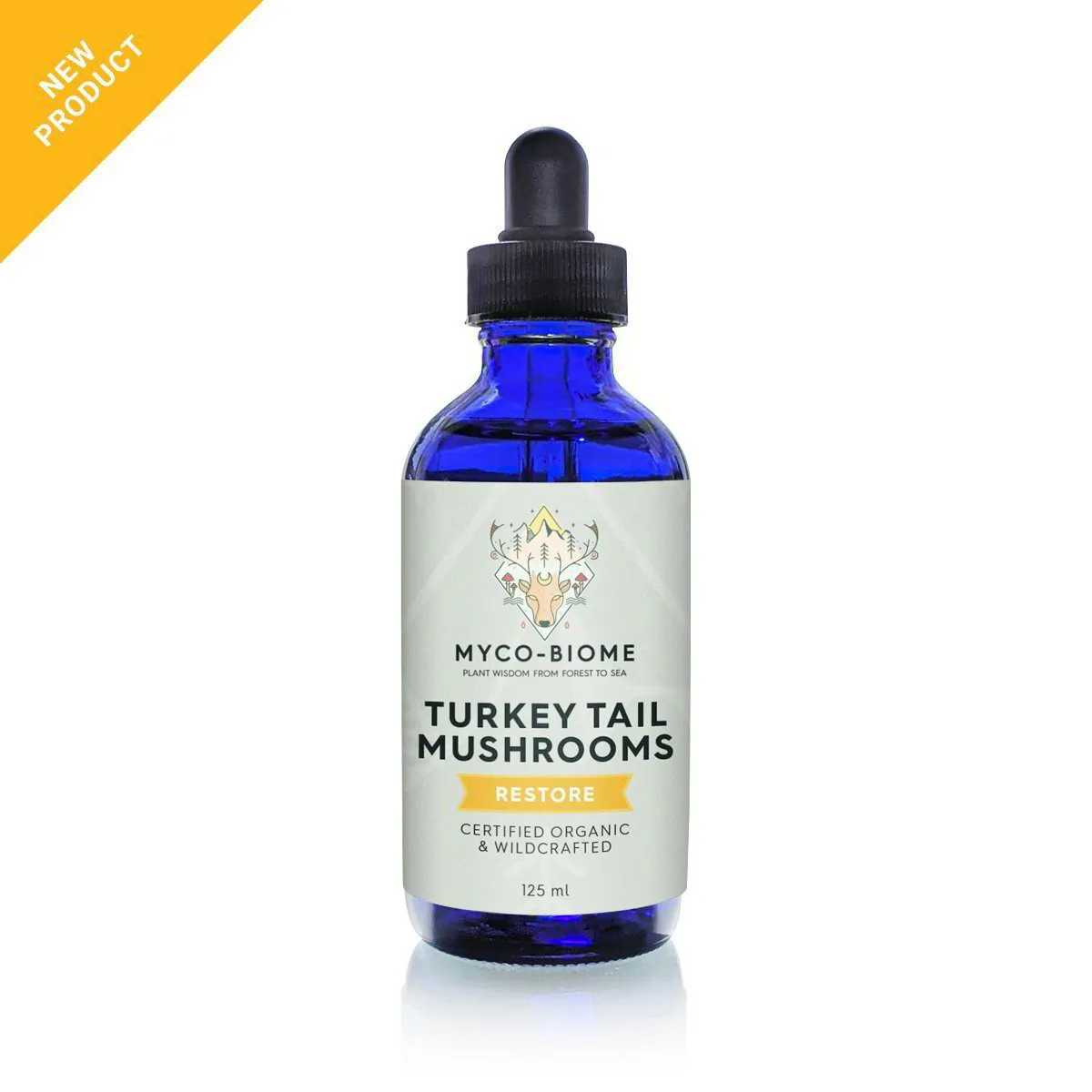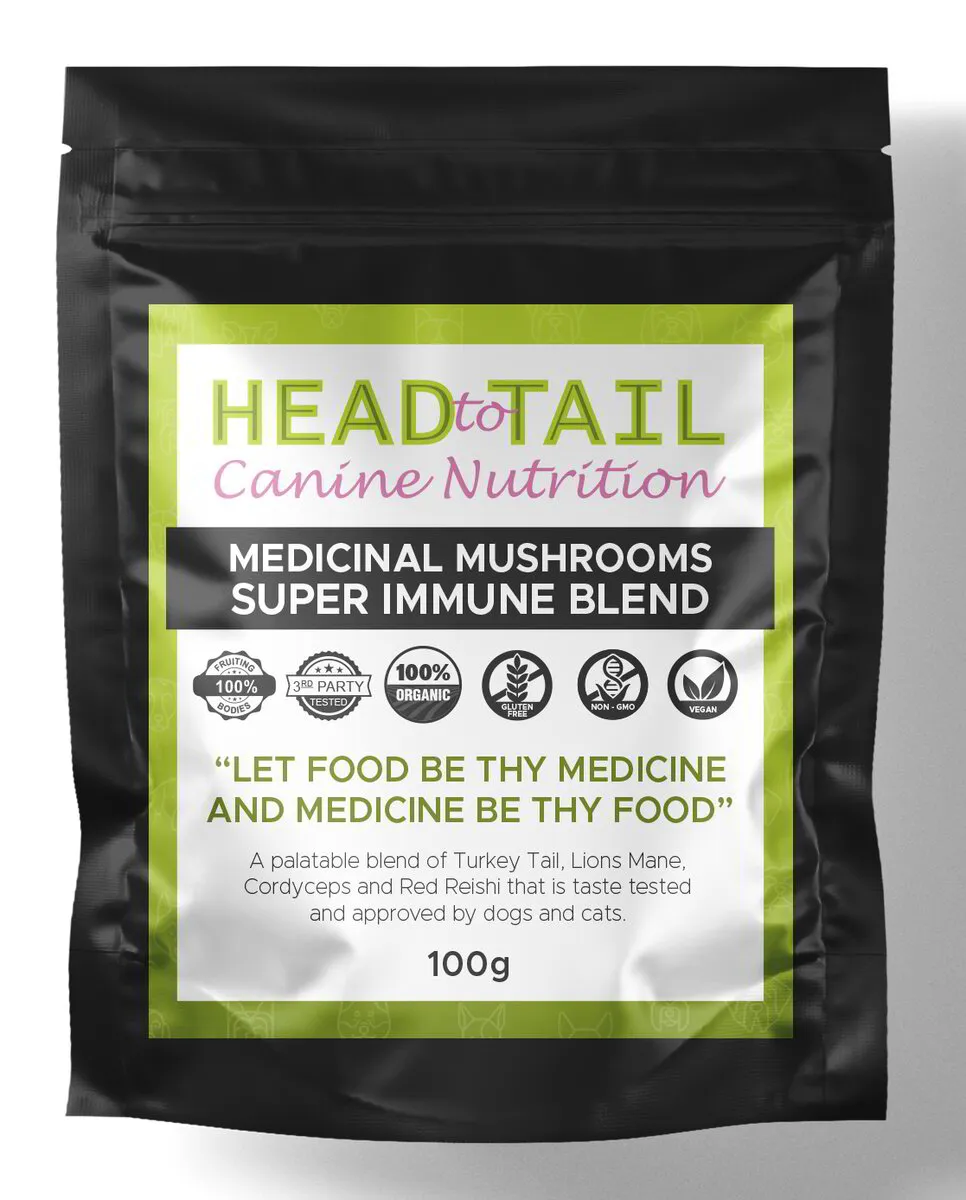Organs and Systems:
Immune, Microbiome
Components:
Polysaccharides, Beta-glucans, Protein-bound
Polysaccharides (A*), Ergosterol
Key Actions:
Turkey tail improves immune function by stimulating cytokine production, increasing natural killer cells, and through other immune-boosting functions.
- Immune "defensive" support
- Adaptogen (B*)
- Cancer support
- Anti-viral activity (C*)
- Inflammation
- Reduced Immunity
- Cancer
- Vaccine titers
- Prebiotic support of microbiome due to fiber content and immune activity (D*)
- It is increasingly being understood that our overall health is highly dependent on our gut health. The composition of the gut microbiota affects everything from digestion to cognitive function
- Liver support (E*)
- Enhances energy
- Supports blood sugar balance (F*)
Organ Affinity:
Heart, Spleen, Liver, Kidney
TCM action:
• Strengthens the Spleen (boosts metabolism and
immunity)
• Regulates fluids
• Clears heat and toxins
(*) see below for more details
NOTE: The following is excerpts from REAL MUSHROOMS.COM
***
(A)“Protein-bound polysaccharides (PBP) found in Turkey Tail have the most research-backed immune-supportive effects. These PBP compounds can enhance key types of immune cells, like T-cells, when used alone or in combination with synergistic herbs [29]. Turkey Tail is a safe mushroom to use long-term within the context of proper medical treatment [23, 32]
Functional mushrooms may also enhance a third immune system known as trained innate immunity, an emerging concept in immunology (56).
Turkey tail combined with Reishi, another functional mushroom, shows even greater possibilities for helping the immune system (57).
(B) Turkey tail mushrooms are adaptogens as are many other mushrooms. Adaptogens help the pets body adapt to the various types of stressors we may come across. This includes physical, biological, or chemical stressors. Adaptogens interact with the hypothalamic-pituitary-adrenal (HPA) axis to help stabilize your cortisol levels under stress and assist the body in reaching balance again.
(C) Turkey's tail contains an impressive range of primary and secondary compounds. The secondary compounds are phenolic acids, flavonoids, and terpenoids. In fact, researchers identified 38 different phenolic compounds, including quercetin and baicalein. Quercitin and baicalein are two phenolic compounds found in other natural plants and herbs with an incredible amount of supportive research and health benefits behind them.
(D) A in vitro human study showed that a turkey tail polysaccharide extract significantly elevated two healthy gut bacterias while reducing the negative bacterias, Clostridium, Enterococcus and Staphylococcus species (Clostridium and Staphylococcus considered pathogenic when overpopulated). These extracts also increased the amount of short-chain fatty acids (another positive marker for a healthy gut), β-galactosidase (lactase), and glucosidase activity. A human study showed clear signs of turkey tail acting as a prebiotic (7,8,9,10).
(E) Results from animal studies suggest that polysaccharide peptide (PSP) in turkey tail could help protect the liver against free radicals by regulating the immune response to the free radical, such as increasing levels of the protective antioxidants SOD, glutathione peroxidase (GSH-Px), and glutathione (GSH) (39).
(F) Animal studies show that PSPs have been shown to support normal insulin sensitivity, which helps maintain blood glucose levels already within a healthy range (44,45,46). These results need to be replicated in clinical trials; however, these initial results in animals are very promising!
Disclaimer: The information in this article is provided as information resources only, and are not to be used or relied on to diagnose, treat, cure, or prevent any disease. This information does not create any patient-doctor relationship, and should not be used as a substitute for professional diagnosis and treatment.. The information in this article is intended for educational purposes. The information is not intended to replace medical advice offered by licensed medical practitioners. Please consult your veterinarian for any medical advice.
References
1. Knežević, A., Živković, L., Stajić, M., Vukojević, J., Milovanović, I. & Spremo-Potparević, B. 2015, “Antigenotoxic Effect of Trametes spp. Extracts against DNA Damage on Human Peripheral White Blood Cells,” The Scientific World Journal, <https://www.hindawi.com/journals/tswj/2015/146378/>.
2. Cui, J. & Chisti, Y. 2003, “Polysaccharopeptides of Coriolus versicolor: physiological activity, uses, and production,” Biotechnology Advances, vol. 21, no. 2, pp. 109–122, <https://www.sciencedirect.com/science/article/abs/pii/S0734975003000028>
6. Kim, H.S., Hong, J.T., Kim, Y. & Han, S.-B. 2011, “Stimulatory Effect of β-glucans on Immune Cells,” Immune Network, vol. 11, no. 4, p. 191. <https://www.ncbi.nlm.nih.gov/pmc/articles/PMC3202617/>
7. Dou, H., Chang, Y. & Zhang, L. 2019, “Chapter Fifteen – Coriolus versicolor polysaccharopeptide as an immunotherapeutic in China,” L. Zhang (ed.),ScienceDirect, Academic Press, <https://www.sciencedirect.com/science/article/pii/S1877117319300353?via%3Dihub#bb0050>
8. Ohno, R., Yamada, K., Masaoka, T., Ohshima, T., Amaki, I., Hirota, Y., Horikoshi, N., Horiuchi, A., Imai, K. & Kimura, I. 1984, “A randomized trial of chemoimmunotherapy of acute nonlymphocytic leukemia in adults using a protein-bound polysaccharide preparation,” Cancer immunology, immunotherapy: CII, vol. 18, no. 3, pp. 149–154, <https://pubmed.ncbi.nlm.nih.gov/6391658/>
9. Harada, M., Matsunaga, K., Oguchi, Y., Iijima, H., Ito, O., Tamada, K., Kimura, G. & Nomoto, K. 1995, “The involvement of transforming growth factor beta in the impaired antitumor T-cell response at the gut-associated lymphoid tissue (GALT),” Cancer Research, vol. 55, no. 24, pp. 6146–6151, <https://pubmed.ncbi.nlm.nih.gov/8521406/>
10. Harada, M., Matsunaga, K., Oguchi, Y., Iijima, H., Tamada, K., Abe, K., Takenoyama, M., Ito, O., Kimura, G. & Nomoto, K. 1997, “Oral administration of PSK can improve the impaired anti-tumor CD4+ T-cell response in gut-associated lymphoid tissue (GALT) of specific-pathogen-free mice,” International Journal of Cancer, vol. 70, no. 3, pp. 362–372, <https://pubmed.ncbi.nlm.nih.gov/9033641/>
11. Hayakawa, K., Mitsuhashi, N., Saito, Y., Nakayama, Y., Furuta, M., Nakamoto, S., Kawashima, M. & Niibe, H. 1997, “Effect of Krestin as adjuvant treatment following radical radiotherapy in non-small cell lung cancer patients,” Cancer Detection and Prevention, vol. 21, no. 1, pp. 71–77, <https://pubmed.ncbi.nlm.nih.gov/9043766/>
12. Nakazato, H., Koike, A., Saji, S., Ogawa, N. & Sakamoto, J. 1994, “Efficacy of immunochemotherapy as adjuvant treatment after curative resection of gastric cancer. Study Group of Immunochemotherapy with PSK for Gastric Cancer,” Lancet (London, England), vol. 343, no. 8906, pp. 1122–1126, <https://pubmed.ncbi.nlm.nih.gov/7910230/>
13. Sakamoto, J., Morita, S., Oba, K., Matsui, T., Kobayashi, M., Nakazato, H., Ohashi, Y. & Meta-Analysis Group of the Japanese Society for Cancer of the Colon Rectum 2006, “Efficacy of adjuvant immunochemotherapy with polysaccharide K for patients with curatively resected colorectal cancer: a meta-analysis of centrally randomized controlled clinical trials,” Cancer immunology, immunotherapy: CII, vol. 55, no. 4, pp. 404–411, <https://pubmed.ncbi.nlm.nih.gov/16133112/>
14. Yamashita, K., Sakuramoto, S., Mieno, H., Nemoto, M., Shibata, T., Katada, N., Ohtsuki, S., Sakamoto, Y., Hoshi, K., Wang, G., Hemmi, O., Satoh, T., Kikuchi, S. & Watanabe, M. 2015, “Preoperative administration of polysaccharide Kureha and reduced plasma transforming growth factor-β in patients with advanced gastric cancer: A randomized clinical trial,” Molecular and Clinical Oncology, vol. 3, no. 3, pp. 471–478, <https://www.ncbi.nlm.nih.gov/pmc/articles/PMC4471616/>
15. Trovato, A., Pennisi, M., Crupi, R., Paola, R.D., Alario, A., Modafferi, S., Rosa, G.D., Fernandes, T., Signorile, A., Maiolino, L. & Calabrese, S.C. and V. 2017, “Neuroinflammation and Mitochondrial Dysfunction in the Pathogenesis of Alzheimer’s Disease: Modulation by Coriolus versicolor (Yun-Zhi) Nutritional Mushroom,” Journal of Neurology & Neuromedicine, vol. 2, no. 1, <https://www.jneurology.com/articles/pneuroinflammation-and-mitochondrial-dysfunction-in-the-pathogenesis-of-alzheimerrsquos-disease-modulation-by-coriolus-versicolor-.html>
16. Volk, T. 2000, “Tom Volk’s Fungus of the Month for November 2000,” Tom Volk’s Fungi, <https://botit.botany.wisc.edu/toms_fungi/nov2000.html>.
17. Fang, X., Jiang, Y., Ji, H., Zhao, L., Xiao, W., Wang, Z. & Ding, G. 2015, “The Synergistic Beneficial Effects of Ginkgo Flavonoid and Coriolus versicolor Polysaccharide for Memory Improvements in a Mouse Model of Dementia,” Evidence-based Complementary and Alternative Medicine : eCAM, vol. 2015, <https://www.ncbi.nlm.nih.gov/pmc/articles/PMC4364004/>
18. Ho, C.Y., Lau, C.B.S., Kim, C.F., Leung, K.N., Fung, K.P., Tse, T.F., Chan, H.H.L. & Chow, M.S.S. 2004, “Differential effect of Coriolus versicolor (Yunzhi) extract on cytokine production by murine lymphocytes in vitro,” International Immunopharmacology, vol. 4, no. 12, pp. 1549–1557, <https://www.sciencedirect.com/science/article/pii/S1567576904002474>
19. Ng, T.B. 1998, “A review of research on the protein-bound polysaccharide (polysaccharopeptide, PSP) from the mushroom Coriolus versicolor (basidiomycetes: Polyporaceae),” General Pharmacology: The Vascular System, vol. 30, no. 1, pp. 1–4, <https://www.sciencedirect.com/science/article/pii/S0306362397000761>
20. Yang, S., Zhuang, T., Si, Y., Qi, K. & Zhao, J. 2015, “Coriolus versicolor mushroom polysaccharides exert immunoregulatory effects on mouse B cells via membrane Ig and TLR-4 to activate the MAPK and NF-κB signaling pathways,” Molecular Immunology, vol. 64, no. 1, pp. 144–151, <https://www.sciencedirect.com/science/article/pii/S0161589014003150?via%3Dihub#bib0095>
22. Lee, C.-L., Sit, W.-H., Jiang, P.-P., So, I.W.-Y. & Wan, J.M.-F. 2008, “Polysaccharopeptide mimics ciclosporin-mediated Th1/Th2 cytokine balance for suppression of activated human T cell proliferation by MAPKp38 and STAT5 pathways,” Journal of Pharmacy and Pharmacology, vol. 60, no. 11, pp. 1491–9 <https://onlinelibrary.wiley.com/doi/abs/10.1211/jpp.60.11.0010>
23. Go, P. & Chung, C.H. 1989, “Adjuvant PSK immunotherapy in patients with carcinoma of the nasopharynx,” The Journal of International Medical Research, vol. 17, no. 2, pp. 141–149, <https://pubmed.ncbi.nlm.nih.gov/2656331/>
24. Nishiwaki, Y., Furuse, K., Fukuoka, M., Ota, M., Niitani, H., Asakawa, M., Nakai, H., Sakai, S. & Ogawa, N. 1990, “[A randomized controlled study of PSK combined immuno-chemotherapy for adenocarcinoma of the lung. The Advanced Lung Cancer Immuno-chemotherapy Study Group],” Gan to Kagaku Ryoho. Cancer & Chemotherapy, vol. 17, no. 1, pp. 131–136, <https://pubmed.ncbi.nlm.nih.gov/2404455/>
25. Eliza, W.L.Y., Fai, C.K. & Chung, L.P. 2012, “Efficacy of Yun Zhi (Coriolus versicolor) on survival in cancer patients: systematic review and meta-analysis,” Recent Patents on Inflammation & Allergy Drug Discovery, vol. 6, no. 1, pp. 78–87, <https://pubmed.ncbi.nlm.nih.gov/22185453/>
26. Brown, D.C. & Reetz, J. 2012, “Single Agent Polysaccharopeptide Delays Metastases and Improves Survival in Naturally Occurring Hemangiosarcoma,” Evidence-based Complementary and Alternative Medicine : eCAM, vol. 2012, <https://www.ncbi.nlm.nih.gov/pmc/articles/PMC3440946/>
27. Sourav, P. & Girdhari, L. 2017, “The Molecular Mechanism of Natural Killer Cells Function and Its Importance in Cancer Immunotherapy,” Frontiers in Immunology, vol. 8, p. 1124, <https://www.frontiersin.org/articles/10.3389/fimmu.2017.01124/full>
28. Yamazaki, H., Yoshioka, Y., Inoue, Takehiro, Tanaka, E., Nishikubo, M., Sato, T., Ishida, T., Nakamura, H. & Inoue, Toshihiko 2002, “Changes in natural killer cell activity by external radiotherapy and/or brachytherapy,” Oncology Reports, vol. 9, no. 2, pp. 359–363, <https://pubmed.ncbi.nlm.nih.gov/11836608/>
29. Torkelson, C.J., Sweet, E., Martzen, M.R., Sasagawa, M., Wenner, C.A., Gay, J., Putiri, A. & Standish, L.J. 2012, “Phase 1 Clinical Trial of Trametes versicolor in Women with Breast Cancer,” ISRN oncology, vol. 2012, p. 251632, <https://www.ncbi.nlm.nih.gov/pmc/articles/PMC3369477/>
30. Chay, W.Y., Tham, C.K., Toh, H.C., Lim, H.Y., Tan, C.K., Lim, C., Wang, W.-W. & Choo, S.-P. 2017, “Coriolus versicolor (Yunzhi) Use as Therapy in Advanced Hepatocellular Carcinoma Patients with Poor Liver Function or Who Are Unfit for Standard Therapy,” The Journal of Alternative and Complementary Medicine, vol. 23, no. 8, pp. 648–52, <https://www.liebertpub.com/doi/10.1089/acm.2016.0136>
31. Ma, Y., Wu, X., Yu, J., Zhu, J., Pen, X. & Meng, X. 2017, “Can polysaccharide K improve therapeutic efficacy and safety in gastrointestinal cancer? a systematic review and network meta-analysis,” Oncotarget, vol. 8, no. 51, <https://www.ncbi.nlm.nih.gov/pmc/articles/PMC5687673/>
32. American Heart Association 2016, “About Metabolic Syndrome,” www.heart.org, <https://www.heart.org/en/health-topics/metabolic-syndrome/about-metabolic-syndrome>
33. Yu, Z.-T., Liu, B., Mukherjee, P. & Newburg, D. 2013, “Trametes versicolor Extract Modifies Human Fecal Microbiota Composition In vitro,” Plant Foods for Human Nutrition, vol. 68, pp. 107–12, <https://link.springer.com/article/10.1007/s11130-013-0342-4>
34. Aida, F.M.N.A., Shuhaimi, M., Yazid, M. & Maaruf, A.G. 2009, “Mushroom as a potential source of prebiotics: a review,” Trends in Food Science & Technology, vol. 20, no. 11, pp. 567–575, <https://www.sciencedirect.com/science/article/pii/S0924224409002295>
35. Pallav, K., Dowd, S.E., Villafuerte, J., Yang, X., Kabbani, T., Hansen, J., Dennis, M., Leffler, D.A., Newburg, D.S. & Kelly, C.P. 2014, “Effects of polysaccharopeptide from Trametes Versicolor and amoxicillin on the gut microbiome of healthy volunteers,” Gut Microbes, vol. 5, no. 4, pp. 458–67, <https://www.tandfonline.com/doi/full/10.4161/gmic.29558>
36. Friedman, M. 2016, “Mushroom Polysaccharides: Chemistry and Antiobesity, Antidiabetes, Anticancer, and Antibiotic Properties in Cells, Rodents, and Humans,” Foods, vol. 5, no. 4, p. 80, <https://www.ncbi.nlm.nih.gov/pmc/articles/PMC5302426/>
37. Li, X., Chen, P., Zhang, P., Chang, Y., Cui, M. & Duan, J. 2019, “Protein‐Bound β‐glucan from Coriolus versicolor has Potential for Use Against Obesity,” Molecular Nutrition & Food Research, vol. 63, no. 7, p. 1801231, <https://onlinelibrary.wiley.com/doi/full/10.1002/mnfr.201801231>
38. Abdel-Moneim, A.M., Al-Kahtani, M.A., El-Kersh, M.A. & Al-Omair, M.A. 2015, “Free Radical-Scavenging, Anti-Inflammatory/Anti-Fibrotic and Hepatoprotective Actions of Taurine and Silymarin against CCl4 Induced Rat Liver Damage,” M.A. Avila (ed.), PLOS ONE, vol. 10, no. 12, p. e0144509, <https://journals.plos.org/plosone/article?id=10.1371/journal.pone.0144509>
39. Chang, Y., Zhang, M., Jiang, Y., Liu, Y., Luo, H., Hao, C., Zeng, P. & Zhang, L. 2017, “Preclinical and Clinical Studies of Coriolus versicolor Polysaccharopeptide as an Immunotherapeutic in China,” Discovery Medicine, vol. 23, no. 127, pp. 207–219, <https://www.discoverymedicine.com/Yajing-Chang-2/2017/04/coriolus-versicolor-polysaccharopeptide-as-an-immunotherapeutic-in-china/>
40. Wang, K.-L., Lu, Z.-M., Mao, X., Chen, L., Gong, J.-S., Ren, Y., Geng, Y., Li, H., Xu, H.-Y., Xu, G.-H., Shi, J.-S. & Xu, Z.-H. 2019, “Structural characterization and anti-alcoholic liver injury activity of a polysaccharide from Coriolus versicolor mycelia,” International Journal of Biological Macromolecules, vol. 137, pp. 1102–1111, <https://www.sciencedirect.com/science/article/abs/pii/S014181301836834X?via%3Dihub>
41. Ren, Y., Geng, Y., Chen, H., Lu, Z.-M., Shi, J.-S. & Xu, Z. 2018, “Polysaccharide peptides from Coriolus versicolor: A multi-targeted approach for the protection or prevention of alcoholic liver disease,” Journal of Functional Foods, vol. 40, pp. 769–777, <https://www.sciencedirect.com/science/article/abs/pii/S1756464617307235?via%3Dihub>
42. Uthayathas, S., Karuppagounder, S.S., Tamer, S.I., Parameshwaran, K., Degim, T., Suppiramaniam, V. & Dhanasekaran, M. 2007, “Evaluation of neuroprotective and anti-fatigue effects of sildenafil,” Life Sciences, vol. 81, no. 12, pp. 988–992, <https://pubmed.ncbi.nlm.nih.gov/17825848/>
43. Ho, C.-S., Tung, Y.-T., Kung, W.-M., Huang, W.-C., Leung, W.-K., Huang, C.-C. & Wu, J.-H. 2017, “Effect of Coriolus versicolor Mycelia Extract on Exercise Performance and Physical Fatigue in Mice,” International Journal of Medical Sciences, vol. 14, no. 11, pp. 1110–1117, <https://www.ncbi.nlm.nih.gov/pmc/articles/PMC5666542/>
44. Wu, Z., Pang, S., Chen, Xiao-xuan, Yu, Y., Zhou, J., Chen, Xi & Pang, L. 2013, “Effect of Coriolus versicolor polysaccharides on the hematological and biochemical parameters and protection against Aeromonas hydrophila in allogynogenetic crucian carp (Carassius auratus gibelio),” Fish Physiology and Biochemistry, vol. 39, no. 2, pp. 181–190, <https://pubmed.ncbi.nlm.nih.gov/22791194/>
45. Yang, B.-K., Kim, G.-N., Jeong, Y.-T., Jeong, H., Mehta, P. & Song, C.-H. 2008, “Hypoglycemic Effects of Exo-biopolymers Produced by Five Different Medicinal Mushrooms in STZ-induced Diabetic Rats,” Mycobiology, vol. 36, no. 1, pp. 45–49, <https://pubmed.ncbi.nlm.nih.gov/23997607/>
46. Xian, H., Che, H., Qin, Y., Yang, F., Meng, S., Li, X., Bai, Y. & Wang, L. 2017, “Coriolus versicolor aqueous extract ameliorates insulin resistance with PI3K/Akt and p38 MAPK signaling pathways involved in diabetic skeletal muscle,” Phytotherapy Research, vol. 32, no. 3, pp. 551–60, <https://onlinelibrary.wiley.com/doi/full/10.1002/ptr.6007>
47. Collins, R.A. & Ng, T.B. 1997, “Polysaccharopeptide from Coriolus versicolor has potential for use against human immunodeficiency virus type 1 infection,” Life Sciences, vol. 60, no. 25, pp. PL383–7, <https://pubmed.ncbi.nlm.nih.gov/9194694/>
48. Karaman, M., Jovin, E., Malbasa, R., Matavuly, M. & Popović, M. 2010, “Medicinal and edible lignicolous fungi as natural sources of antioxidative and antibacterial agents,” Phytotherapy research: PTR, vol. 24, no. 10, pp. 1473–1481, <https://pubmed.ncbi.nlm.nih.gov/20878697/>
49. Donatini, B. 2014, “Control of Oral Human Papillomavirus (HPV) by Medicinal Mushrooms, Trametes versicolor and Ganoderma lucidum: A Preliminary Clinical Trial,” International Journal of Medicinal Mushrooms, vol. 16, no. 5, pp. 497–8, <https://pubmed.ncbi.nlm.nih.gov/25271984/>
50. Matijašević, D., Pantić, M., Rašković, B., Pavlović, V., Duvnjak, D., Sknepnek, A. & Nikšić, M. 2016, “The Antibacterial Activity of Coriolus versicolor Methanol Extract and Its Effect on Ultrastructural Changes of Staphylococcus aureus and Salmonella Enteritidis,” Frontiers in Microbiology, vol. 7, <https://www.ncbi.nlm.nih.gov/pmc/articles/PMC4972825/>
51. Kim, B.-L., Lim, K.-O., Han, S.-R., Kim, K.-H. & Oh, T.-J. 2017, “Antimicrobial activities of various extracts of Coriolus versicolor against oral bacteria,” Journal of Korean society of Dental Hygiene, vol. 17, no. 1, pp. 111–122, <https://www.koreascience.or.kr/article/JAKO201711437355415.page>
52. Palacios, S., Losa, F., Dexeus, D. & Cortés, J. 2017, “Beneficial effects of a Coriolus versicolor-based vaginal gel on cervical epithelization, vaginal microbiota and vaginal health: a pilot study in asymptomatic women,” BMC Women’s Health, vol. 17, no. 1, <https://link.springer.com/article/10.1186/s12905-017-0374-2>
53. McCleary, B.V. & Draga, A. 2016, “Measurement of β-Glucan in Mushrooms and Mycelial Products,” Journal of AOAC International, vol. 99, no. 2, pp. 364–373, <https://pubmed.ncbi.nlm.nih.gov/26957216/>
54. Fritz, H., Kennedy, D.A., Ishii, M., Fergusson, D., Fernandes, R., Cooley, K. & Seely, D. 2015, “Polysaccharide K and Coriolus versicolor Extracts for Lung Cancer,” Integrative Cancer Therapies, vol. 14, no. 3, pp. 201–11, <https://pubmed.ncbi.nlm.nih.gov/25784670/>
55. Memorial Sloan Kettering Cancer Center 2019, “Coriolus versicolor | Memorial Sloan Kettering Cancer Center,” www.mskcc.org, <https://www.mskcc.org/cancer-care/integrative-medicine/herbs/coriolus-versicolor>
56. van Steenwijk, H. P., Bast, A., & de Boer, A. (2021). Immunomodulating Effects of Fungal Beta-Glucans: From Traditional Use to Medicine. Nutrients, 13(4), 1333. https://doi.org/10.3390/nu13041333
57. Donatini B. (2014). Control of oral human papillomavirus (HPV) by medicinal mushrooms, Trametes versicolor and Ganoderma lucidum: a preliminary clinical trial. International journal of medicinal mushrooms, 16(5), 497–498. https://doi.org/10.1615/intjmedmushrooms.v16.i5.80
58. https://www.clinicaltrials.gov/ct2/show/NCT04667247
59. https://clinicaltrials.gov/ct2/show/NCT04951336
60. Zhong, L., Yan, P., Lam, W. C., Yao, L., & Bian, Z. (2019). Coriolus Versicolor and Ganoderma Lucidum Related Natural Products as an Adjunct Therapy for Cancers: A Systematic Review and Meta-Analysis of Randomized Controlled Trials. Frontiers in pharmacology, 10, 703. https://doi.org/10.3389/fphar.2019.00703
Disclaimer: The information or products mentioned in this article are provided as information resources only, and are not to be used or relied on to diagnose, treat, cure, or prevent any disease. This information does not create any pet-veterinarian relationship, and should not be used as a substitute for professional diagnosis and treatment. Any products mentioned are not intended to diagnose, treat, cure, or prevent any disease. The information in this article is intended for educational purposes. The information is not intended to replace medical advice offered by a licensed veterinarians. Please consult your veterinarian for any medical advice.
Overwhelmed? Have Questions?
Contact an Advanced Certified
Canine Nutritionist Now
8 years of Experience
Reliable
Apply Now & Get A Free 10 minute Consultation
We will not send spam
Let us be part of your pets health team!!
Yes, learning, sourcing, and preparing a raw food diet takes time BUT...
Armed with knowledge and supported by a certified canine nutritionist, your end results will bring wellness to your dog’s life.
Donna Middleton is a certified canine nutritionist with a proven track record of helping Dog owners with their Dog's condition and wellbeing.
She will equip you with knowledge of your dog’s nutritional needs while supporting you with the education and steps that you should take to keep your dog healthy and happy.
Medical Disclaimer
This information is intended to provide information only. Each animal health situation is unique. This information is not intended for use in the diagnosis or treatment of specific health problems or diseases, and should never be considered as a substitute for veterinary advice.
By Donna Middleton Advanced Certified Canine Nutritionist ACCN
Head to Tail Canine Nutrition
Follow Donna FaceBook:
https://www.facebook.com/headtotailnutrition




